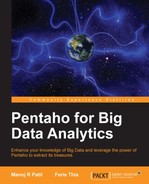This chapter provides a basic understanding of visualizations and examples to analyze the patterns using various charts based on Hive data.
In this chapter, we will cover the following topics:
- Evolution of data visualization and its classification
- Data source preparation
- Consumption of HDFS-based data through HiveQL
- Preparation of various charts
- Beautification of the charts using styling
Data visualization is nothing but a representation of your data in graphical form. For example, assume you run your data analytics plan and get an enriched data set, which needs to be further studied to extract patterns. In spite of you putting your filtered analyzed data into tabular form with a sorting feature, it would be very difficult to find out the pattern and trend. Even more difficult is to share the findings with the community in case you spot it. Because the human visual cortex dominates our perception, representing data in the form of a picture would accelerate the identification of hidden data patterns.
So, an easy alternative is to represent the data in a graphical manner in terms of charts, which will give a better aesthetic view as well as functionality. This data visualization will communicate information in a crisp, clear, and concise manner. Ideal visualization should not only communicate the information efficiently, but also arouse the viewer's engagement and attention.
Data visualization is associated with information, statistics, and science. In fact, it would be interesting to look at the evolution of data visualization.
The following diagram shows the data visualization journey:

The origin of data representation evolved from geometric diagrams, in the form of celestial bodies such as stars, and in the making of maps to aid in navigation and exploration. The 18th century saw further growth in this field while humanity was starving for navigation, surveying, and territory expansion. A contour diagram was used for the first time in this period.
In the first half of the 19th century, the world saw a lot of inventions in statistical theories initiated by Gauss and Laplace along with huge industrialization. In the anticipation of a pressing need to represent growing numerical information; in the 20th century, the data visualization unfolded into a mature, rich, and multidisciplinary research area. A lot of software tools were made available with data visualization, which was the first dynamic and highly interactive multidimensional data.
KPI Library has developed A Periodic Table of Visualization Methods, which includes the following six types of data visualization methods:
- Data visualization: This is a visual representation of numeric data in schematic drawing (typically with axes). Examples for this type are pie and bar charts.
- Information visualization: This makes use of the visual representation of data—computer supported and interactive in nature—to magnify cognition. It is independent of computers and may involve senses other than seeing, such as sound and touch. Examples are data flow diagrams and Venn diagrams.
- Concept visualization: This is a visual representation to exhibit generally qualitative concepts, plans, ideas, and analysis. Examples are mind maps and Vee diagrams.
- Strategy visualization: This is the systematic use of complemented visual representations in strategic analyses, development, conceptualization, communication, and the implementation of various strategies in organizations. An example for this type is a life cycle diagram.
- Metaphor visualization: This is a visual metaphor showing information graphically in the form of real-life representations to organize and structure information. This metaphor also represents deep insight through the key characteristics of metaphor that are employed. An example of this type is a funnel.
- Compound visualization: This is the hybrid use of various graphic representation formats to represent a single schema. An example is a cartoon.
